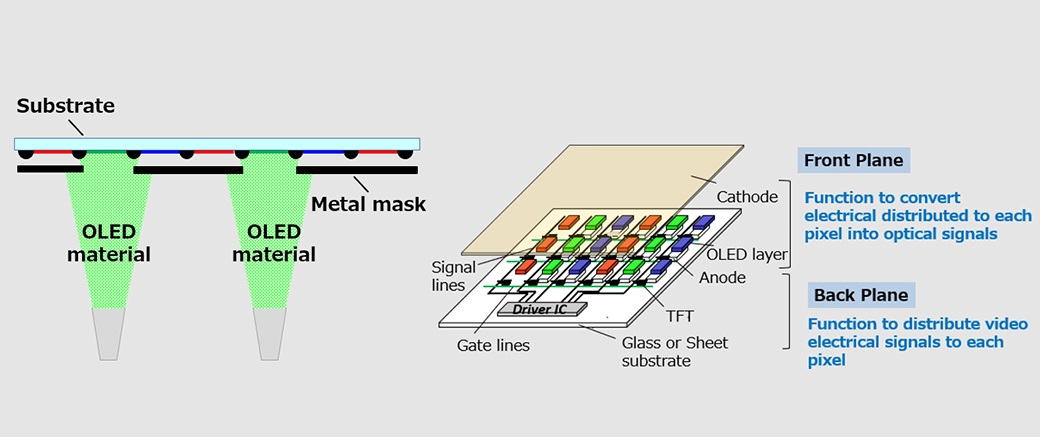-
Display Basics




Liquid Crystal
Liquid crystal refers to the intermediate status of a substance between solid (crystal) and liquid. When crystals with a high level of order in molecular sequence are melted, they generally turn liquid, which has fluidity but no such order at all. However, thin bar-shaped organic molecules, when they are melted, keep their order in a molecular direction although they lose it in molecular positions. In the state in which molecules are in a uniform direction, they also have refractive indices, dielectric constants and other physical characteristics similar to those of crystals, depending on their direction, even though they are liquid. This is why they are called liquid crystal. The diagram below shows the structure of 5CB (4-pentyl-4’-Cyanobiphenyl) as an example of liquid crystal molecules.
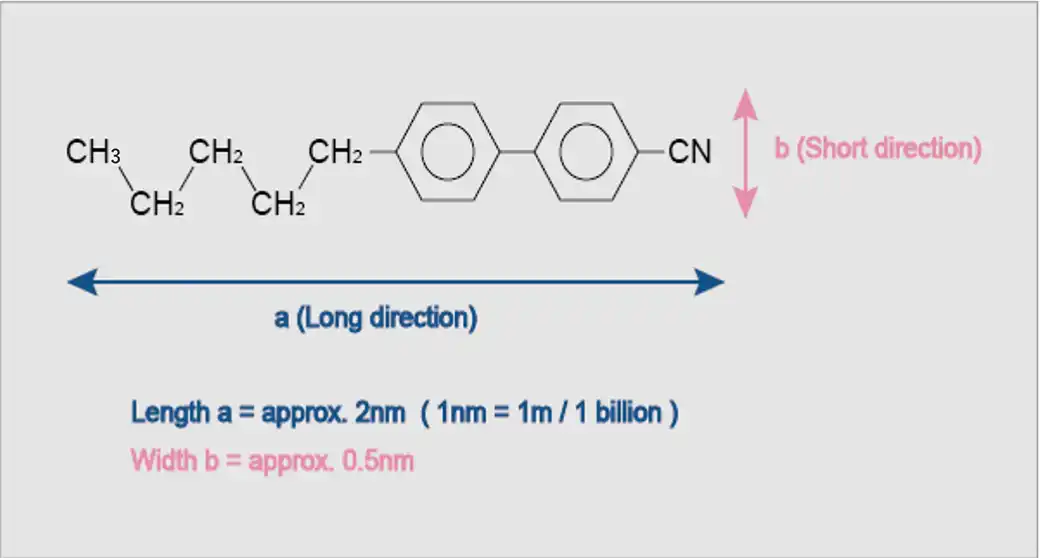
Operating Principle of Liquid Crystal Displays
A liquid crystal display (LCD) has liquid crystal material sandwiched between two sheets of glass. Without any voltage applied between transparent electrodes, liquid crystal molecules are aligned in parallel with the glass surface. When voltage is applied, they change their direction, and they turn vertical to the glass surface. They vary in optical characteristics, depending on their orientation. Therefore, the quantity of light transmission can be controlled by combining the motion of liquid crystal molecules and the direction of polarization of two polarizing plates attached to both outer sides of the glass sheets. LCDs utilize these characteristics to display images.
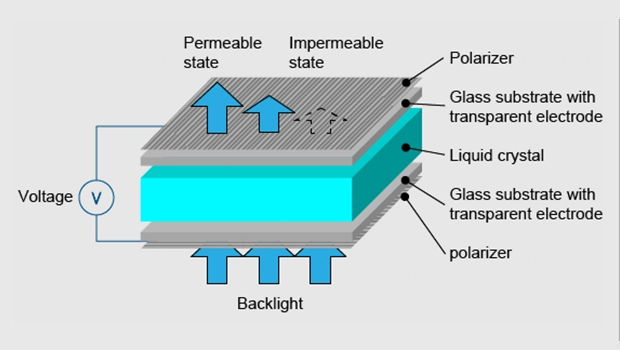
TFT LCD
An LCD consists of many pixels. A pixel consists of three sub-pixels (Red/Green/Blue, RGB). In the case of Full-HD resolution, which is widely used for smartphones, there are more than six million (1,080 x 1,920 x 3 = 6,220,800) sub-pixels. To activate these millions of sub-pixels a TFT is required in each sub-pixel. TFT is an abbreviation for "Thin Film Transistor". A TFT is a kind of semiconductor device. It serves as a control valve to provide an appropriate voltage onto liquid crystals for individual sub-pixels. A TFT LCD has a liquid crystal layer between a glass substrate formed with TFTs and transparent pixel electrodes and another glass substrate with a color filter (RGB) and transparent counter electrodes. In addition, polarizers are placed on the outer side of each glass substrate and a backlight source on the back side. A change in voltage applied to liquid crystals changes the transmittance of the panel including the two polarizing plates, and thus changes the quantity of light that passes from the backlight to the front surface of the display. This principle allows the TFT LCD to produce full-color images.
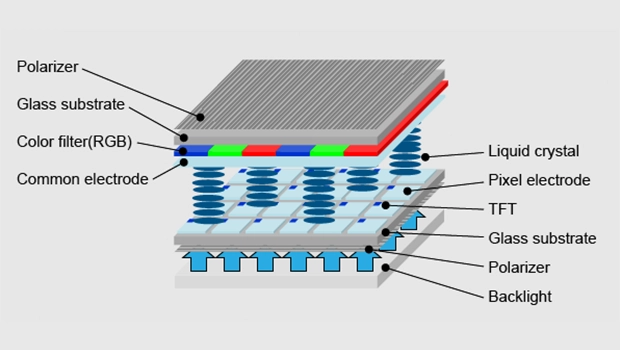
OLED
OLEDs are light-emitting devices that utilize organic materials that can convert electrical energy into light (electroluminescence). They are called Organic Light Emitting Diodes (OLEDs) because their electrical current characteristics exhibit diode characteristics. Because OLED displays are self-emitting, they are characterized by high contrast, fast response time, and thinness. The color of an OLED is specific to the organic material (organic molecules) and varies depending on its structure.
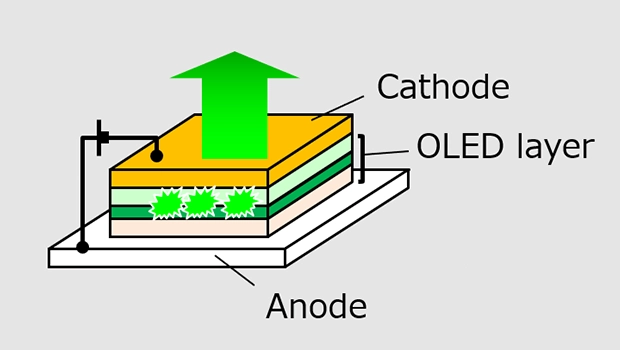
OLED Structure and Light Emission Principle
OLEDs consist of an organic film of several hundred nanometers in thickness sandwiched between electrodes. Light is emitted through the three-step process of carrier injection from the electrode, carrier transport, and exciton generation by recombination. Because the organic material used typically has insulating characteristics, thin organic layers are used to conduct current, and a stacked structure made from the appropriate materials is required to reduce interfacial barriers. It is important to be able to control carrier balance and confine excitons to achieve efficient and stable luminescence. To achieve this, OLEDs generally use a multilayer stacked structure with each layer having its own function.
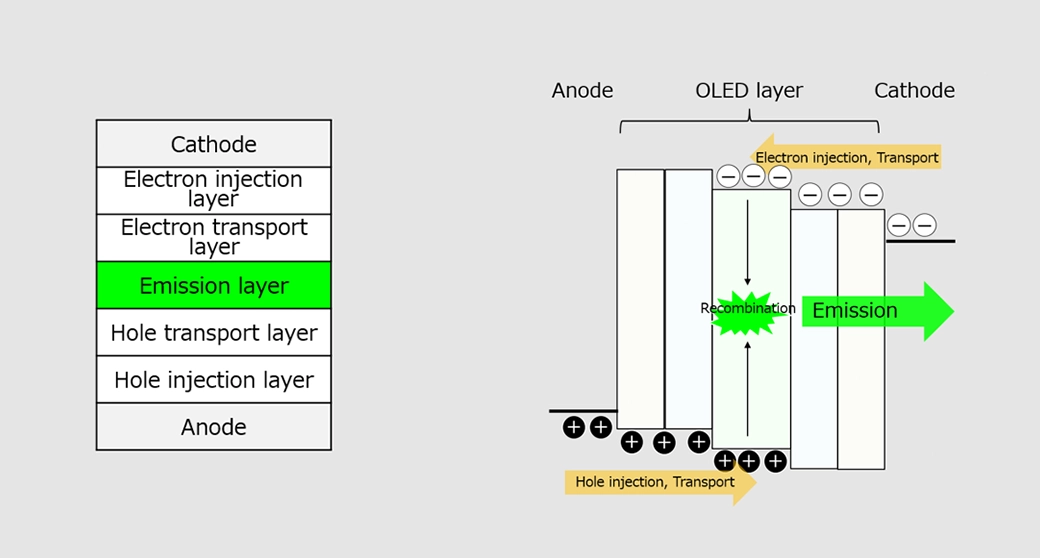
OLED Displays
The key components of an OLED display are a thin film transistor (TFT), OLED, encapsulation film (barrier film), polarizer and cover glass. The OLED film is generally formed by vacuum evaporation, which enables thin film formation on the order of 10 nm and multilayer OLED film formation. OLED displays have many pixels and are composed of three RGB (red-green-blue) sub-pixels. For an OLED display to be self-luminous, each sub-pixel must be patterned with an RGB light-emitting device. When forming the film by vacuum evaporation, patterning is usually done using a fine metal mask. OLED materials are generally susceptible to moisture and oxygen, and their characteristics deteriorate significantly when exposed to the atmosphere. Therefore, the OLED film must be protected by an encapsulating film with excellent barrier properties. In the past, encapsulation by glass lamination was used, but in recent years, solid-state encapsulation using resin has become more common, enabling thinner and more flexible displays.
